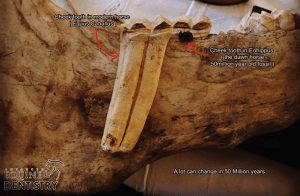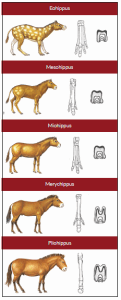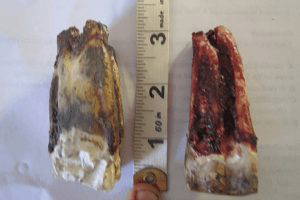WORDS BY Dr Shannon Lee
BVSc, MANZCVSc Eq Dent, DICEVO
Personally, I find it pretty amazing that we are fortunate enough to be able to look back at the evolution of the modern horse (Equus Caballus) thanks to the existence of a fossil record. Whilst examining such a long period in history means some areas are still educated guesses, having access to so many fossils does answer many questions and provides a solid base for establishing what happened, when and how.
Some of you may be aware that fossil records allow for the identification of what is thought today to be the first discovered ancestor of the modern horse. This animal called Hyracotherium, or Eohippus, was around the size of a large dog and consumed a diet of leaves. In other words, it was a browsing animal; whereas today’s horses would be considered grazing animals; that is, it ate small trees and shrubs, where modern horses eat grass.
Not only has much changed in the overall size of the animal, but the fossil record shows incredible changes in dentition also took place as animals adapted to a changing environment.
The modern horse comes in many shapes, sizes and styles. However, it may surprise you to know that modern horses (Equus Caballus) encompass all breeds – from Miniature horses through to large breeds like the Suffolk Punch, Clydesdale and Percheron. Evidence suggests the modern horse has only been around for approximately 10,000-15,000 years.
Granted that 15,000 years might seem like a long time. However, it’s just a blink when we are looking at a timeline for the evolution of the horse of more than 55 million years. If we place the evolution of the horse into a 24 hour time scale, i.e. as if the 55 million years had occurred over a period of 24 hours, then the modern horse has evolved in fewer than the last 30 seconds.
Given the horse’s evolution and, therefore, its dental evolution has been occurring over a much greater period of time than the modern horse has been in existence, it should not be surprising to learn there’s far less difference dentally across different breeds of horses than there is going back through fossil records.
As an example, take the time to look at the photos:
IMAGE A: The first shows two cheek teeth extracted from horses. On the left is a cheek tooth from a 10-year-old Clydesdale-cross mare weighing 550kg; on the right is a cheek tooth from a 7-year-old Miniature mare weighing 55kg. Notice the teeth are, essentially, the same size.
 IMAGE B: Now, look at the second image, which shows the bottom jaw of a modern Thoroughbred horse, a cheek tooth from a 4-year-old and a cheek tooth from the horse’s ancestor of 55 million years earlier (Eohippus). Note the incredible changes in size and shape that have taken place over that time.
IMAGE B: Now, look at the second image, which shows the bottom jaw of a modern Thoroughbred horse, a cheek tooth from a 4-year-old and a cheek tooth from the horse’s ancestor of 55 million years earlier (Eohippus). Note the incredible changes in size and shape that have taken place over that time.
You Are What You Eat:
Let’s look in more depth what changes have taken place. How and why did they come about and. more importantly, why do they matter to you as an owner of a modern-day horse?
As can be seen in Images A and B above, there are incredible differences in the size and shape of the teeth of a modern horse when compared to one that roamed the earth 55 million years ago. Yet, as you see from another image, the teeth of modern horses are very similar in size and shape, regardless of the enormous physical differences between different breeds.
Why is this? Why is it that being a similar size to its ancestor Eohippus a Miniature horse doesn’t have similar teeth?
(A) Diet: Modern horses, regardless of their size, share the same basic diet which is grass-based.
(B) Time: I’m not suggesting that, over time, the teeth of small horses will return to being more like those of Eohippus (whose diet was totally different). However, going back to the evolutionary clock, if modern horses have roamed the earth for just 30 seconds on our 24-hour clock of evolution, then you can see the length of time that people have bred and selected for specific shapes, sizes and types of horses is very short indeed.
(C) Selection: Modern horses are selectively bred to a certain shape, colour, size, pace, etc. This contrasts with the evolution of the horse, where selection ![]() occurred over many generations based on certain traits, which helped the animal to adapt, to be better suited to its environment and to, therefore, survive and produce more offspring.
occurred over many generations based on certain traits, which helped the animal to adapt, to be better suited to its environment and to, therefore, survive and produce more offspring.
When we look at the evolution of the horse, we won’t actually find a straight line. Although horse species A did lead to B and then C and so on until we arrived at the modern horse, there were also many other branches in that evolutionary tree and, at different times, multiple species existed alongside each other (or so the fossil evidence suggests).
It is thought about 20 million years ago, significant changes in the environment, which resulted in more open grasslands, lead to the rapid development of multiple species of horse.
As an example, around some 10 million years ago, it is thought there were up to a dozen different species of horse all living during the same time period in what was the open grasslands found in North America. These horses ranged significantly in terms of size and shape.
An Odd Family…
No discussion of the evolution of the horse would be complete without looking at the evolution of species thought to be closely related to the modern horse (Equus Caballus).
The Equidae family consists of seven species. Other than Equus Caballus, the other species are types of asses (including donkeys) and zebra. The Prezwalski horse is thought to be of the same species as the modern horse.
Because taxonomy (the science of classification) is based on fossil records and classification of physical characteristics, historically, animals with toes are grouped together into a class called ungulates, and are then divided into even- and odd-toed groups.
According to this classification, the closest living relatives of the modern horse are considered to be the rhinoceros and the tapir. This has some important practical consequences.
For example, it has been the author’s experience to be asked, on occasion, to perform dental procedures on both these non-equine species. Each time, because the classification system states horses are the near relative of both the rhino and the tapir, the wildlife or zoo vets have approached the author with the idea that performing dental procedures, such as the removal of teeth, will be a simple matter as the anatomy techniques and equipment can simply be transferred from horses.
In fact, the anatomy, dentition, techniques, size and shape of the oral cavity of rhinos and tapirs are vastly different from horses. So, if you are a veterinarian reading this, perhaps take away that, whilst an equine dental vet can help you with your rhino or tapir, it will be a fair leap from practicing dentistry in horses, zebras and donkeys.
Just as the dentition of the modern horse is vastly different from its ancestor of 55 million years ago, the dentition of rhinos and tapirs has also had a long evolutionary path and resembles little of that which is found in the equids.
Looking at Change…
Let’s talk specifically about how these changes occurred in the Equidae family – horses, zebras and asses – and what these changes were.
1: In order to cope with the much more abrasive diet of grass, horses evolved teeth that where much larger and longer, and could wear down over time while some of the remaining tooth erupted into the mouth to help replace what had been worn away. This type of tooth is classified as a Hypsodont tooth, whereas 55 million years ago, Eohippus or ‘The Dawn Horse’ had smaller, short-crowned teeth (the crown refers to the part of the tooth you can see in the mouth).
Eohippus teeth are classified as brachyodont teeth and much more closely resemble our own human teeth
The reason a grass diet requires longer teeth, capable of adapting to the increased wear, is that grasses contain silicates as does soil. Silicates can be thought of as tiny particles of glass, similar to what you find in sand paper, so they are more abrasive and cause increased wearing of the teeth.
To cope with a grass diet, and the increasing body size, the evolving species of horses needed to consume (as anyone who has cared for modern horses knows) large volumes of feed each day. Not only did this rapidly increase the effects of abrasion, but conversely, it provided evolutionary advantage to any animal that could digest its feed better, reduce the effects of dental wear or reduce the time needed to graze. So, with this in mind, fossil records provide a fascinating window into how and when these adaptations occurred as species evolved.
Interestingly, as we’ve already touched on, evolution did not occur in a straight line and is still going on around us. One study conducted at the University of Oregon examined fossils from four species of horse that existed around 16 million years ago.
By examining the structure and thickness of the enamel in the teeth of specimens in all four groups – Anchitheriinae, Merychippine-grade Equinae, Hipparionini, and Equini – they discovered changes in the structure and increased thickness in the enamel occurred over time as an adaptation to the changing environment and diet. Interestingly, they discovered these changes have not yet occurred to the same degree in modern horses.
These fossils are from North America and horses in North America are thought to have become extinct around 10,000 years ago. Modern horses were re-introduced to North America from ‘the old world’ (Europe) only around 500 years ago. So, when you think of the American Mustang or Brazilian Mangalarga, these distinctive and iconic breeds have, in fact, only been in existence for a blink of the evolutionary clock. Despite them appearing very different, again it’s little surprise that in many ways they are, in fact, not as dissimilar as you imagine.
The wolf tooth
Through the years, the number of cheek teeth, their shape, size, position and classification are some of the changes that can be observed in the fossil record.
I mentioned earlier evolution is still occurring in the modern horse, albeit with human help. While the earliest horses had seven cheek teeth, modern horses have only six. Yet, many of you will be familiar with the term ‘wolf tooth’.
The wolf tooth is one that some horses get, while others do not. The number of these teeth, their size and even their position are all widely varied. These teeth are often removed in modern horses to avoid bitting issues and, if present, they erupt into the mouth at a young age (6- 12 months).
The evolutionary link is that wolf teeth are the first premolar tooth – the first cheek tooth – and so what we are witnessing with the variation in size, shape, position, and whether a horse gets them or not, is actually a step in the dental evolution of the modern horse. With the intervention of humans selectively breeding, it might even happen faster…
What is occurring is that horses have evolved to have only six (much larger) cheek teeth and the wolf tooth is a throwback – a genetic link to the past. In some ways, it might help to think about it like wisdom teeth in humans. After all, not everybody develops wisdom teeth and what is their purpose in the mouth of humans? Even after 55 million years of evolution, that seventh tooth (the wolf tooth) is still hanging around.
Search
Recent Articles
- How to take a horse from SHOES to BAREFOOT with Alex Ridgeway & Dr Mark Caldwell
- 8 Laminitis Myths Busted!
- I’ve learnt as I’ve got older to really listen to what the people around me say about others
- The dangers of sleep deprivation in horses
- The third part of our series on stretching and flexibility with Sharon Stuart or Stuart Equine – forelimb and neck stretches for the horse and shoulder stretches for the rider
Categories
- Advice Hub
- Athlete
- Carriage Driving
- Dentistry
- Dressage
- Endurance
- Eventing
- Farrier
- Featured
- Featured Horse Ads
- Featured Posts
- Horse Racing
- Horse's Mouth
- Horseball
- Hunting
- Le Trec
- Leisure Riders
- Mounted Games
- Nutrition
- Polo
- Polocrosse
- Reining
- Rescue & Rehabilitation
- Show Jumping
- Showing
- Tack Room
- Team Chasing
- The Pony Club
- Therapy
- Training
- Vaulting
- Veterinary




